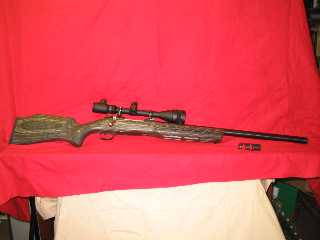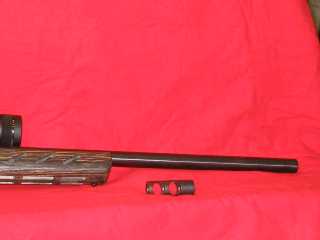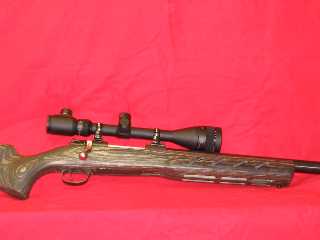FIELD TEST HESSE ARMS BOLT ACTION RIFLE
by
Bill Black
 The test rifle was
originally built by the Hesse Arms Co. of Minnesota (now defunct).
The rifle was based upon a Mauser 98 receiver, which had been rebarrelled
to fire the 7.62x51mm NATO cartridge. The barrel was not marked by
its manufacturer. Overall length of the barrel was approximately 26-inches,
including the attached muzzle brake. The barrel diameter was approximately
1 ½-inches. The stock which was issued by Hesse Arms, consisted
of a wood laminate in an alternating black and grey color pattern.
The forearm area of the stock was machined with air ventilation slots.
A ¾- inch thick rubber recoil pad was installed on the butt.
No sling hardware had been provided by the factory; however, the rifle’s
receiver had been drilled and tapped to accept Weaver scope base mounts.
The test rifle was
originally built by the Hesse Arms Co. of Minnesota (now defunct).
The rifle was based upon a Mauser 98 receiver, which had been rebarrelled
to fire the 7.62x51mm NATO cartridge. The barrel was not marked by
its manufacturer. Overall length of the barrel was approximately 26-inches,
including the attached muzzle brake. The barrel diameter was approximately
1 ½-inches. The stock which was issued by Hesse Arms, consisted
of a wood laminate in an alternating black and grey color pattern.
The forearm area of the stock was machined with air ventilation slots.
A ¾- inch thick rubber recoil pad was installed on the butt.
No sling hardware had been provided by the factory; however, the rifle’s
receiver had been drilled and tapped to accept Weaver scope base mounts.
The rifle scope, which was premounted onto the rifle, is imported from Russia
by the American Technology Network Corp. of San Francisco. This particular
scope was a 6-18 power by 65mm, with the main body tube measuring 30mm in
diameter. The scope rings were the ‘High Base’ type and were too
high, as I had to raise my head quite a bit off of the stock comb in order to
see through the scope properly. I also had the distinct feeling that the scope
base mounts might not have been mounted exactly parallel, as there was a
slight, but noticeable, variance when I checked them with a straight- edge.
After bore-sighting the rifle, it was time to head to the range and see what it
could do.
 For maximum stability,
all range firing was done from a bench supported position. For my
first round of testing I used 147grain Lake City military ball (FMJ)
ammunition. The distance to the target was a measured 50 yards. The
Lake City ammo produced a 2-inch diameter shot group which was about
6- inches to the right of the point of aim. For my next test series
I used 148grain Wolf ball ammo. This shot group also impacted 6-inches
to the right of the point of aim, however, I was a bit surprised to
see the Wolf produce a 1-inch diameter shot group. At this point in
the testing I had become aware of two things: 1) The bolt was extremely
hard to close on any of the test ammo, and would not close at all
when I had tried to chamber a round of M852, 175grain military match
ammo! (2) To bring the scope into coincidence for ‘point of
aim’ equals ‘point of impact’, I had to adjust the
windage approximately 80- clicks left, which reinforced my suspicion
that the two individual receiver bases for the scope, were in fact
not perfectly parallel with each other. The reticle in the scope was
intended for pure target shooting, as both the verticle and horizontal
‘cross-hairs’ were extremely hard to define in bright
sunlight and would disappear completely when I shifted my field of
view into the nearby tree line. In my opinion this type of reticle
is totally unsuitable for hunting duties.
For maximum stability,
all range firing was done from a bench supported position. For my
first round of testing I used 147grain Lake City military ball (FMJ)
ammunition. The distance to the target was a measured 50 yards. The
Lake City ammo produced a 2-inch diameter shot group which was about
6- inches to the right of the point of aim. For my next test series
I used 148grain Wolf ball ammo. This shot group also impacted 6-inches
to the right of the point of aim, however, I was a bit surprised to
see the Wolf produce a 1-inch diameter shot group. At this point in
the testing I had become aware of two things: 1) The bolt was extremely
hard to close on any of the test ammo, and would not close at all
when I had tried to chamber a round of M852, 175grain military match
ammo! (2) To bring the scope into coincidence for ‘point of
aim’ equals ‘point of impact’, I had to adjust the
windage approximately 80- clicks left, which reinforced my suspicion
that the two individual receiver bases for the scope, were in fact
not perfectly parallel with each other. The reticle in the scope was
intended for pure target shooting, as both the verticle and horizontal
‘cross-hairs’ were extremely hard to define in bright
sunlight and would disappear completely when I shifted my field of
view into the nearby tree line. In my opinion this type of reticle
is totally unsuitable for hunting duties.
 I quickly found out
why the bolt had been so difficult to close on all of the testing
ammunition. Upon checking the rifle’s chamber for proper headspace,
it would not close the bolt on a Forester (1.630) ‘GO’
gauge! Time to pull the barrel out of the receiver and do some serious
lathe work! After rechambering the barrel with my trusted .308NATO
match reamer, the bolt would now close perfectly on the Forester ‘GO’
gauge. So, what was the original problem with the chamber? It was
obvious that when Hesse Arms had done the original chambering job,
they had missed the proper chambering depth in the barrel by exactly
0.017-inch too short. I know that doesn’t sound like much, but
in the chambering business that equates to about 10-yards on a football
field! While I was in the shop, I recontoured the receiver rails so
that the ammunition would feed better from its magazine and I also
recontoured the bottom surface of the rear scope base so that it was
level with the height of the front scope base. Time for more range
testing.
I quickly found out
why the bolt had been so difficult to close on all of the testing
ammunition. Upon checking the rifle’s chamber for proper headspace,
it would not close the bolt on a Forester (1.630) ‘GO’
gauge! Time to pull the barrel out of the receiver and do some serious
lathe work! After rechambering the barrel with my trusted .308NATO
match reamer, the bolt would now close perfectly on the Forester ‘GO’
gauge. So, what was the original problem with the chamber? It was
obvious that when Hesse Arms had done the original chambering job,
they had missed the proper chambering depth in the barrel by exactly
0.017-inch too short. I know that doesn’t sound like much, but
in the chambering business that equates to about 10-yards on a football
field! While I was in the shop, I recontoured the receiver rails so
that the ammunition would feed better from its magazine and I also
recontoured the bottom surface of the rear scope base so that it was
level with the height of the front scope base. Time for more range
testing.
For this test series, I switched to a well trusted Simmons Model-1074, 6.5-20
by 40mm hunting scope with a very well defined duplex ‘cross-hair’
reticle. Distance to target for this test was 100-yards. My first three shot
group was in an old and familiar area 5 ¼-inches to the right of my
point of aim. After 40-rounds and much cranking of left windage, I was finally
able to bring the shot group into coincidence with the point of aim. Good
progress, but something was still seriously wrong with this rifle. Back to the
shop we go.
At this point in time there were only a few problem areas which could still
exist in this rifle. The first thing was to remove the factory installed muzzle
brake. Once that was off of the barrel it was easy to see that Hesse Arms had
drilled the ‘thru-hole’ on the muzzle brake off center in relation
to the bore. Back to the lathe to put a recessed target crown into the barrel!
Next came glass bedding of the stock to the receiver/barrel assembly. Back to
the range we go.
 With another well
trusted Simmons Model 801-057, 6.5-20 by 40mm, MIL- DOT reticle scope
mounted and bore-sighted to the rifle, it was once again time to see
what the rifle would do as before, distance to target was 100- yards.
For my first group I used 147grain Lake City FMJ/Ball ammo. My group
was 5 ½-inches right of my point of aim, the group size had
shrunk down to a respectable 1 ½-inches in diameter. Not a
bad start, so I ran some 168grain Federal Gold Medal Match ammo through
the rifle. My average group measured 2 ¼-inches in diameter!
Did this rifle not like the 168grain projectile? To test my theory
I next fired some hand-loads that I had been working up using a 168grain
Sierra Hollow-Point Boat Tail, being pushed by 45. grains of Varget
powder, over a Federal #210 primer. Interesting, once again my shot
group was a respectable 1 ½-inches in diameter!
With another well
trusted Simmons Model 801-057, 6.5-20 by 40mm, MIL- DOT reticle scope
mounted and bore-sighted to the rifle, it was once again time to see
what the rifle would do as before, distance to target was 100- yards.
For my first group I used 147grain Lake City FMJ/Ball ammo. My group
was 5 ½-inches right of my point of aim, the group size had
shrunk down to a respectable 1 ½-inches in diameter. Not a
bad start, so I ran some 168grain Federal Gold Medal Match ammo through
the rifle. My average group measured 2 ¼-inches in diameter!
Did this rifle not like the 168grain projectile? To test my theory
I next fired some hand-loads that I had been working up using a 168grain
Sierra Hollow-Point Boat Tail, being pushed by 45. grains of Varget
powder, over a Federal #210 primer. Interesting, once again my shot
group was a respectable 1 ½-inches in diameter!
After all of the above, where are we with regard to this Hesse Arms rifle?
Well, THIS Hesse Arms rifle is now capable of holding a 10-inch group all the
way out at 700-yards, with the right ammo and a good shooter. As for other
Hesse Arms rifles, as this one, save your money!
Bill Black is a distinguished rifle and pistol shooter; #60 in the United
States Navy. He graduated from the Colorado School of Trades (Gunsmithing) in
1984. He builds match-grade rifles specializing in M1A and M14.
[ JPFO Home > Life
Preserver Bouyancy Testing > A Detailed Test & Evaluation
of the MAS-49/56 .308 NATO Self-Loading Rifle (SLR) ]
© 2000 JPFO < webmaster@jpfo.org
>